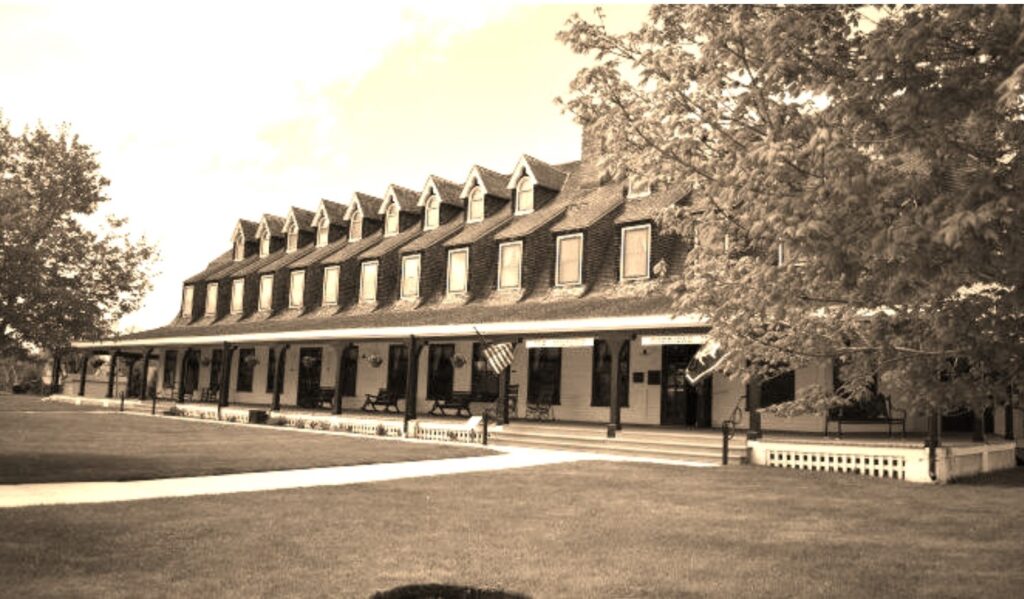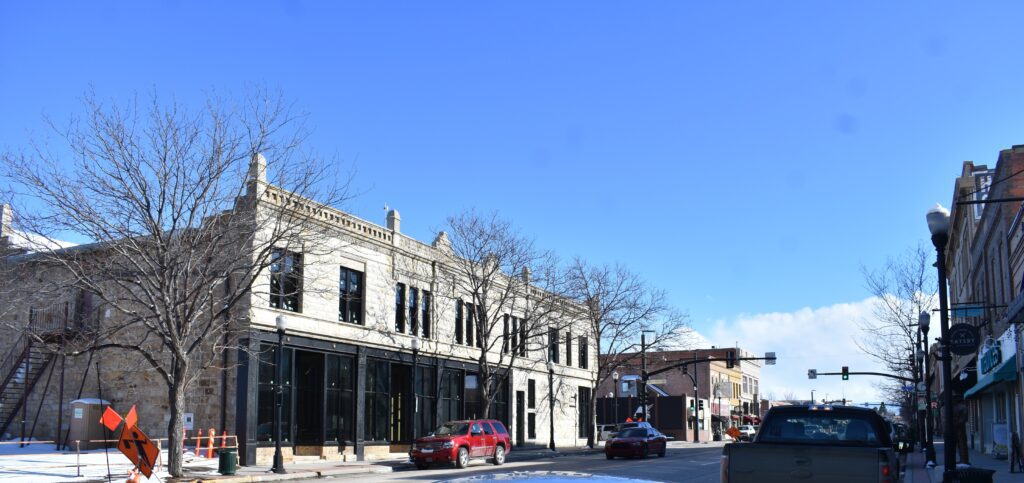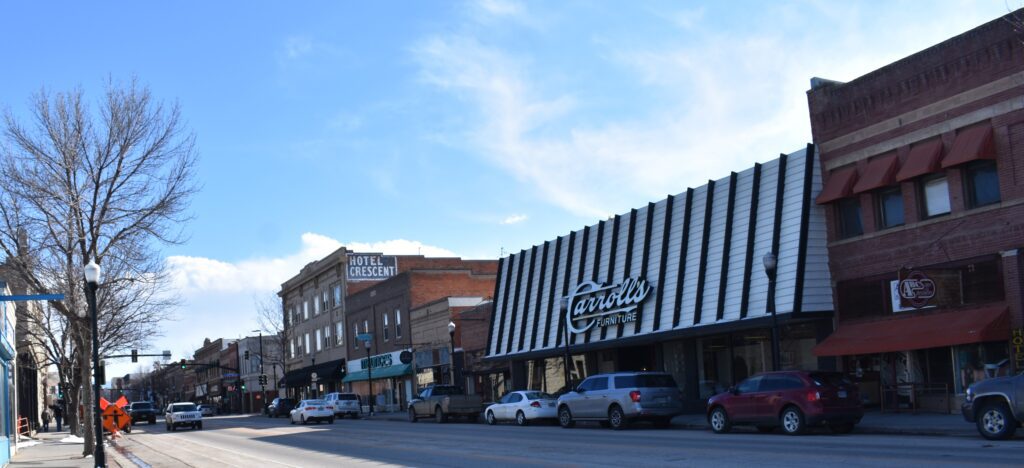News
Sheridan’s Main Street First Paved 100 Years Ago

With the construction beginning on Sheridan’s Main Street, this week we take a look back in time to when Sheridan went from mud streets to paved streets, and some of the comments for and against the new paving projects. This will be an ongoing series of stories about Main Street.
As we see in the stories from the Sheridan newspapers of the time, there were a lot of comments, most were in favor of the paving projects. To those who looked into the future and wanted Sheridan to be a modern city, paving was a necessity. Although this article does not address Main Street as much, it gives a good feel of what people thought at the time.
This from The Sheridan Enterprise, December 24, 1919 – Whole-Hearted Endorsement is Given to Paving Projects by Scores of Owners of Property. Prevailing Sentiment Is That Paving Must Go Through At Once if Sheridan is To Lay Claim to Advancement. Since certain opposition has been developing against paving, many people have been calling upon the city officials and endorsing their action and urging them to use every effort to make their proposed program effective. A number of these people, who were interviewed today, expressed themselves in favor of the paving. Friday night there will be a mass meeting in the council chambers of the City Hall at which the taxpayers of the city are invited to be present.
Various phases of the paving question will be presented and a general discussion will take place. “No one should stand in the way of the paving because as an individual he cannot afford.” Said J.T. Jensen, who, if paving goes through, will have to pay for the paving on two sides of his property.
“Now, I not infrequently see patrons of the Linden school drive their cars there and see them mired down in the mud. It is 100% public necessity that the street be paved. What is true there applies to nearly every other street that it is proposed to pave. What of it, if an individual I cannot afford paving, or does not want paving. He can sell it and move to another mudhole. There will be plenty left.”
“I want paving in front of my house on East Works street,” said T. G Scott. “I want it because I want to be able to get to my home at all times of the year. Now there are times when a saddle horse will mire down.”

This segment of the article describes very well what many residents felt was a move upward for the growing city of Sheridan, and that paving the streets was necessary to bring Sheridan into the 20th Century. Today, when most towns of any size have at least some paved streets, that we forget that at one time the streets in Sheridan were mud. Sometimes deep mud.
“Sheridan has passed beyond the cow-trail stage,” said C. S. Mills, president of the school board. “We are trying to build a city and we can not do so with a cow-trail policy with regard to our streets. Let us pave them. It is only fair to the people who have paid for the pavement on the other streets of the city. Am I for paving Park Street? Well, I should say I am. It is the worst street in town. Why, I saw four big horse hitched to an empty wagon stalled in the mud on that street. It ought to have been paved long ago. The more paving that is done at once the cheaper it will be for all.”

No One Could Live in MUD – “Of course I could get along without paving on Gould street,” said D.D. Warren, proprietor of the Sheridan Inn. “But I signed the petition to have it paved and I have 200 feet to pave. I don’t see how any one living on one of these mud streets could oppose paving.”
“I would like to see the city paved.’ said C. W. Garbutt, who owns 66 feet in the proposed district.
“I favor the paving of Brooks and Burkitt street, ” said J. V. Telander, whose home is on the corner of those streets.
“I certainly am in favor of the paving of Linden Avenue,” said T. T. Tynan, former mayor of the city, who resides on that street. “There are a number of very good reasons why that should be paved. First it is a main thoroughfare, leading to cemetery. The drainage on the street is very poor and a large amount of water from the surrounding hills drain on this street. Finally the street is not wide and the paving would not prove burdensome. The street should be paved by all means. I believe that Burkitt street should be paved as it is also a main thoroughfare.”
In another article from the same paper quoted above there is this piece.
Some Reasons Why Sheridan Should Pave – Following are some of the facts concerning the proposed paving brought out at a meeting of the directors of the Commercial club and city officials yesterday. The city council will refuse to enter into any paving contract that will cost more than the paving in district No. 8, which was paved last year.
The city council will ask for bids on seven different kinds of paving and that it is likely that a lower bid can be secured than the bid on the paving in district No. 8. The city council has included in the proposed paving districts, streets leading to the hospital, streets connecting with the main country thoroughfares, streets leading to the cemetery, streets which are in a deplorable condition because of unavoidable bad drainage conditions, street surrounding or adjacent to public schools.
Much of the prosperity and development of the city during the past few years has resulted from the paving of the streets now paved. The paving now in existence is a benefit to all the people and it is unfair to the property owners who are paying for it, that paving extension should cease.
The city of Casper is now the best paved city in the state and not Sheridan. That city also intends to largely extend its paved area during the coming year. Hardin, a neighboring town, with less than one-third the population of Sheridan, now has six miles of pavement, one mile less than Sheridan, and plans to extend its paving six miles during the coming year, tracking a total of 12 miles.
During the coming year $300,000,000 will be expended in the United States on road construction, most of which will be for paved roads. That fact is regarded as conclusive evidence that highway engineers and road experts are not expecting any material decrease in paving costs in the immediate future. The paving laid in 1914, during a period when conditions were most favorable with regard to prices, cost $2.10 a square yard. In 1918 under wartime conditions the same kind of paving cost only $2.50 a square yard. The advance was less than 20 per cent.
Of course, like today, weather could be a factor when paving the roads, and it could sometimes be a race against time to finish before the Wyoming winter would set in. Also, paving was a new thing back in 1923, and, like most new things, people had to try it out.

This from the Sheridan Post-Enterprise, November 4, 1923 – Two Working Shifts Put On Main Street – Two shifts of laborers were placed at work on the Main Street paving Saturday, working from 6 a.m. until 10 p. m. The intersections of BrundageStreet and Grinnell Avenue were added to the block of completed paving between Grinnell avenue and Alger avenue, and finishing of another block between the intersections by Sunday night was being predicted.
“Pray for good weather for the rest of the month.” pleaded E. C. Gwillim city engineer on Saturday, as the only item of news he had for the reporter. He expects that the main paving project at least will be finished by the end of November if the weather holds good. Some Sheridanites are affected peculiarly by the completed pavement. Several automobiles have been observed to make the complete circuit of the lone block of paving completed on street several times, apparently trying to “see how it feels.”
As today, sometimes the paving project didn’t run as planned. Not only weather affected the work, but other problems caused delays in the paving.
Two articles from the Sheridan Post-Enterprise in 1923, mention some of the delays.
(Nov. 1) – A break at the paving plant caused a cessation of the work of paving Main Street late Wednesday afternoon but Thursday morning repairs had been made and the work resumed. The bottom layer of bituminous material had been laid the entire block between Grinnell Avenue and Brundage Street by noon Thursday.
(Nov. 9) Material Arrives, Paving Is Resumed – The car of asphalt paving material which was necessary for resumption of paving operations on Main Street arrived Friday morning and work began at noon. The car had been expected for several days by the officials of the Warren Construction company, but it had failed to arrive, causing a complete cessation of all paving activity during most of this week.
Of course, sometimes the paving created other problems, such as accidents, until speed limits, school zones and stop lights were initiated.

This was an opinion piece in the Sheridan Post-Enterprise, November 27, 1923, talking about safety on Sheridan’s streets. – Immediate Action Necessary – The number of automobile accidents lately means that if something is not done by the city and county officials and every civic organization in our city, Sheridan will soon be known as the city that doesn’t care whether you live or not.
Friday’s accident proves that some drivers do not care for life or anything else and a good reward should be offered and this party or parties brought to justice. Thursday evening a serious accident happened near the courthouse but the matter was not reported for some unknown reason.
Cars are allowed to PLOW thru our residence streets at the rate of 40 miles an hour, and it’s a wonder that more people, especially school children are not killed or crippled. While the motor cycle cop was on duty, it was reasonably safe to be out on the streets at night, but now you’d better keep close to some building or you will be picked off by some thoughtless wild eye speed fiend. While the paving was going on and Main Street blocked, cars turned around on the side streets but it was necessary, now with Main Street paved this same rule is in effect by certain motorists and the party trying to live up to the rules is placed in an embarrassing position.
For jay walkers we have just as many violators, you never know when some one is going to pop out and run across the street and at the intersections you can count fifty a day jay walking across almost any intersection in the business district, and they don’t all come from the country either.
A Safety First Committee should be organized to work with the City and County officials like they do in other cities and a campaign put on to educate the people and after this is carried on for some time and the reckless driving or the jay walker keeps going put a few of the reckless ones in jail for thirty or sixty days with bread and water and the second time soak them for good measure a five hundred dollar fineand life will be a good deal safer than it is now. Signed by W. D. Fisher, Secretary Custer Battlefield Hiway.

Today Sheridan can be proud of their town, their paved streets and rules and laws in place to keep safe. But 100 years ago, it took a lot of work and some arguments to create the modern town we have now.
Next week we will look at some of the businesses then and now on Main Street, and upcoming stories will take a look at the darker side of Sheridan 100 years ago.


Diane Davis
April 8, 2023 at 9:42 am
It was the early 70s that they completely tore up Main Street and repaved it. I know because I was working at a store downtown,